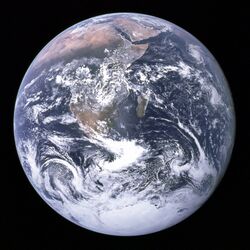Earth: Difference between revisions
(Created page with "{{Infobox planet |name = Earth |native name = |image = Earth.jpg |alt = |caption = Earth as seen by Apollo 17, December 1972 |system = Sol, III |moons = 1 (Luna) |satellites = Von Braun Station |diameter = 12,742 km |day_length = ~24 hours |year_length = 365.2425 days |gravity = 1 g |atmosphere = * 78.08% nitrogen (N<sub>2</sub>) <small>(dry air)</small> * 20.95% oxygen (O<sub>2</s...") |
mNo edit summary |
||
| Line 20: | Line 20: | ||
|temperature = 15.0 °C (59°F) | |temperature = 15.0 °C (59°F) | ||
|adjective = Terran | |adjective = Terran | ||
|population = 9 | |population = 9,749,000 <small>(before 2295)</small><br>490,000 <small>(2295)</small> | ||
|government = [[North Atlantic Conglomerate]]<br>[[United Republics of Bharat]]<br>[[Technocratic State of Argentina]]<br>[[Holy Arab League]]<br>[[New Russian Republic]]<br>[[Russian Federation]] | |government = [[North Atlantic Conglomerate]]<br>[[United Republics of Bharat]]<br>[[Technocratic State of Argentina]]<br>[[Holy Arab League]]<br>[[New Russian Republic]]<br>[[Russian Federation]] | ||
}} | }} | ||
Revision as of 18:49, 2 April 2024
| Earth | |
|---|---|
 Earth as seen by Apollo 17, December 1972 | |
| Star, Position | Sol, III |
| Moon(s) | 1 (Luna) |
| Artificial satellite(s) | Von Braun Station |
| Diameter | 12,742 km |
| Length of day | ~24 hours |
| Length of year | 365.2425 days |
| Surface gravity | 1 g |
| Atmosphere composition |
|
| Mean temperature | 15.0 °C (59°F) |
| Adjective | Terran |
| Population | 9,749,000 (before 2295) 490,000 (2295) |
| Government | North Atlantic Conglomerate United Republics of Bharat Technocratic State of Argentina Holy Arab League New Russian Republic Russian Federation |
Earth, also referred to as Terra, is the third planet from Sol and the first celestial body to have been known to harbor life. It is the planet of origin of humans, who have since colonised dozens of other star systems. For centuries it was the cultural and political center of the Orion Arm, despite being slowly running out of resources and suffering from overpopulation. Earth was partially destroyed during World War III, which led to a rise of sea levels by around 100 meters. It was later completely destroyed during the Great Orion War in 2295, leaving less than half a million survivors on the dying planet.